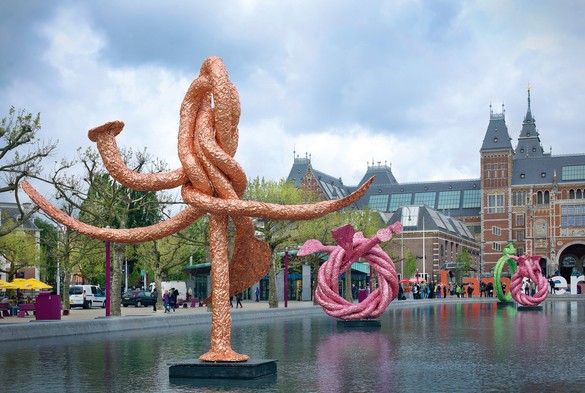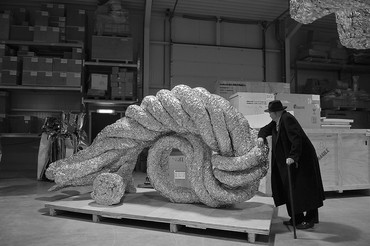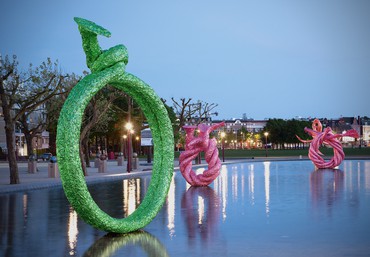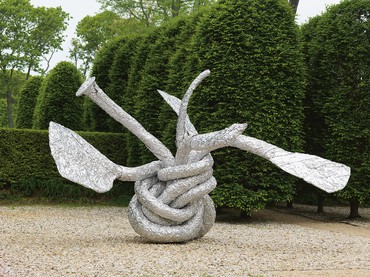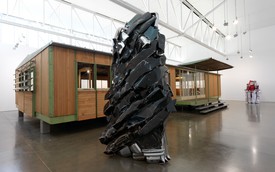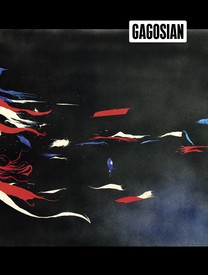
Corinna Thierolf is chief curator at the Pinakothek der Moderne, Munich, where she specializes in postwar art. The organizer of numerous exhibitions, she has also published widely about the work of Joseph Beuys, John Cage, John Chamberlain, Walter de Maria, Dan Flavin, Willem de Kooning, Andy Warhol, and others. Thierolf is the driving force behind the Pinakothek’s Königsklasse exhibition series.
On a memorable summer day in 1958, John Chamberlain found a roughly thirty-year-old Ford in the back yard of his friend Larry Rivers’s house in Southampton, Long Island. In this rusted car the sculptor discovered the Carrara marble of the twentieth century. Removing the fenders from a vehicle that seemed to him worthless (although to the absent Rivers it was a desirable old-timer), he drove over the metal in his own car, deforming it and thereby liberating it from its original function. By bending, crumpling, and twisting the refractory material, he lent it a new, suggestive vibrancy. Such was the origin of his first, iconic sculpture using car parts, which would be followed by a virtually endless wealth of sculptures also made out of auto-body parts. From the unorthodox combination of these expansive individual fragments, with their molded swellings, compression waves, and folds, Chamberlain set free a vitality, rhythm, and movement that make the works highly emotional. In an intriguing transformation, they continue the ancient tradition of sculpture while also setting themselves apart from it through what the artist called the “unprecedented knowledge or information” they contain.1
The work that grew out of this beginning was both various and influential, but there were other no less surprising turns in Chamberlain’s career. His childhood experience of inflating and deflating paper bags was an early big bang in his search for unexplored qualities in sculptural materials and processes. Equally inspiring was a series of events that began in the favored nightclub of the New York art scene in the mid-’60s: “There’s a memory of all of us sitting around Max’s Kansas City at night, waiting for John to finish a pack of cigarettes, because when he crumpled it, he crumpled it like nobody else could.”2 From these crumplings it is only a stone’s throw to the artworks that he crumpled with his bare hands, without the assistance of presses and other tools, beginning in 1966. For these works he employed, among other things, paper, foam, and, even this early, aluminum foil, which was to become an essential material for him in his last years. Some of these works he made so quickly that he referred to them as “instant sculptures”; snapshots of quickly passing moments in an endless chain of sculptural transformation, they occasionally achieved permanence, for example in the Penthouse series of 1969, for which Chamberlain dipped crumpled and painted paper bags in synthetic resin. In each of these works a familiar, readily available object became a new, unfamiliar one.
Chamberlain was in open dialogue with his materials, responding strongly and sensitively to their specific qualities—their density, weight, pliancy. Like a dancer, he engaged in a kind of paso doble with the material, getting to know his partner, courting it, observing it, taking it to its physical limits, bending it, twisting it, and finally leading it through marvelous light-footed pirouettes. He pushed himself to his limits as well, but he never bent metal until it cracked, or tore paper into shreds; he had no wish to dominate his materials, rather to explore the collaboration between two forces at work on each other: the artist and his medium. This pair danced a dynamic creative duet on an equal footing, exposing both their separate natures and their symbiotic association in a deliberately unplanned development.
Chamberlain’s approach had an unveiled eroticism, a quality of erotic partnership particularly clear in the works made of painted and chromed automobile parts—irreducibly disparate yet integrated with a perfect “click” into a whole. Chamberlain called this unity being “in the fit.” The “meshing” of individual sculptural units is a core concept of his work: “Each part is different and each part can fit to some place convenient to itself. In other words, if you have two, not only do they become much stronger because of their union, but they tend to develop certain lines in relation to each other that suggest a marriage.”3 Chamberlain used being “in the fit,” and his method in general, as a metaphor for sexuality, or in a broader sense for the whole spectrum of interactions between living creatures. The idea is clear in such sculptures as the late VENERABLEFRIENDSHIP (2008), whose shiny, towering chrome body is individualized through the pressing process and expressively charged, so that its internal “personalities” continually turn toward each other, support each other, or appear to collapse before each other.4
Chamberlain’s sculpture probed the limits of the possible. Through weight, dimensions towering or broad, or extreme angles, some works have a dramatic physical presence while others suggest a touching physical fragility. In a process as instinctive as it was intense, Chamberlain successively incorporated each work’s components into a whole. His direct handling of the material was crucial; as he put it, “Magic moments are to be allowed to happen spontaneously.”5 Indirect processes—the tactical development of a sculpture out of a sketch, or any tinkering with it after the fact—were foreign to this master of improvisation and intuition.
Chamberlain described art as a place of discovery. He managed to use familiar materials to create something unknown.
Corinna Thierolf
A group of twenty-nine small, freestanding works that Chamberlain made out of aluminum foil in the mid-1980s is no exception.6 He squeezed the foil into elongated shapes, which he bent and sometimes twisted together, then formed the ends into shovel shapes. Only around four inches tall, and made by hand without the use of tools, these sculptural narratives fit into the palm of the hand yet catapult the viewer far beyond their miniature dimension through their concentration and suggestiveness. Auguste Rodin, in The Hand of God (c. 1907), had formed a male and a female figure cradled in a larger hand (modeled on his own) from a block of stone, thus alluding to the biblical act of creation and the artistic one. Though no longer figurative, Chamberlain’s aluminum-foil sculptures also illustrate the original creative activity in which material is shaped in direct interplay with the artist’s eye and hand. Developing them completely manually, he organized and realized even the most sweeping visions he had in mind. Each work stands as a concetto, to use Giorgio Vasari’s term—the valid visualization of an idea.
Part of Chamberlain’s idea for these sculptures was to reproduce them at a much grander scale. But there were technical barriers, for if the sculptures were to remain stable and balanced, the enlargement required a stronger material: aluminum sheets that could not be worked anything like as easily as the household foil that Chamberlain had originally used. Before 2007, then, the largest sculpture he made of this kind was about a foot tall. That year, though, he came to know Ernest Mourmans, who runs a renowned workshop in Belgium that specializes in the complex technical challenges involved in working with metals and other materials; artists and designers who have worked with him include Frank Stella and Ron Arad. Mourmans visited the artist in his home on Shelter Island, New York, where he saw in the studio a rather unconvincing attempt at enlarging the small works in aluminum foil. When Chamberlain told him about his experience with these works, Mourmans was able to imagine a way of enlarging them.
So began a working relationship both fruitful and intensive. Already eighty years old, Chamberlain made repeated trips to Belgium, where, after a break of many years, he once again began to make works out of old auto-body parts but also concentrated on his Foil Adventures, which Mourman had found a way to produce at a size of up to sixteen feet tall without losing the unpretentious nature of the palm-size structures, each with its own “record of dimples, peaks and valleys across its surface” and its “high reflectivity.”7 Chamberlain would recall,
I make the small sculptures, and Ernest just makes them larger. . . . Ernest has a huge warehouse or studio in Belgium. . . . [He and his guys] are very good at enlarging my models into full-scale, hand-formed aluminum foil sculptures. . . .
I’m the one who decides the shape and material . . . whenever an issue comes up, I have the authority. And [Ernest] is very good about the way he runs his shop and makes the objects. Art isn’t really work. Art isn’t labor. When it’s labor, it’s better to have someone who is an expert that does it every day. These guys are much more experts.8
His sculpture generally combines an extreme sense of physical movement with an astonishing stability, perfectly capturing a moment of surprise in a physical form.
Corinna Thierolf
Between 2007 and 2011, all twenty-nine of Chamberlain’s aluminum miniatures from the 1980s were realized in the desired size. The artist had decided that each should be produced in an edition of three; he also established that they should be made in one of four colors, silver, green, copper, or pink (a palette for technical reasons more limited than he originally desired), without repetition within an edition. Beyond these conditions there is no recognizable system in his choices of the color to be used in a sculpture. When first shown—at the More Gallery in Giswil, Switzerland, the Pinakothek der Moderne in Munich, the Guggenheim Museum in New York, and in impressive outdoor settings such as the Royal Botanic Garden in Edinburgh and the grounds of the Rijksmuseum in Amsterdam—they were installed both as single figures and in groups. In each case, they engaged in a dancelike relationship with the space around them. Chamberlain explained,
They have a physical feeling of dance. It’s the way people move their bodies and hands. Somebody might look at this like a prehistoric animal, but it’s really just three rings and has six hands. . . .
You know what a circle looks like with the ends coming out. I can make a circle and make the ends come out like hands or feet. Well this one, ROSETUXEDO, dances.9
Chamberlain described art as a place of discovery.10 Again and again, he managed to use familiar materials to create something unknown. The aluminum-foil works confront the viewer with alien creatures that impose unfamiliar challenges. Yet as emphatically as they depart from sculptural tradition and resist slick comparisons, their novelty arises from an idiosyncratic improvisation on the cultural canon. Lawrence Weiner explains,
I learned that important thing which Chamberlain knew as well, exclusion leads to nothing. Inclusion could be a pain in the ass, but it’s better to be inclusive than exclusive. That’s in Chamberlain’s work. Everything that came along was an influence on him.11
Chamberlain was perfectly candid in letting this wealth of influence into his work. Like a jazz musician who achieves mastery in free improvisation, he worked out of both a comprehensive knowledge of his aesthetic tradition and a full command of his own style, and also from his experiences with his materials, their size and color. It was on this foundation that he made his spontaneous combinations and associations, producing “splendilicious” improvisations in which tradition and present-day experience enter into a homogeneous whole.12
Chamberlain was in open dialogue with his materials, responding strongly and sensitively to their specific qualities—their density, weight, pliancy.
Corinna Thierolf
If Chamberlain’s process of free association made the viewer unlikely to recognize anything familiar in his work, it was precisely this quality that motivated him to the continuation of his creative method. The work and its perception needed to be brought “in the fit.” The sculptures’ colors, glowing as if after a storm, and the angularity of their folds make me think of El Greco’s painting Feast in the House of Simon (1608/14)—a painting that Chamberlain admired, and that he said hello to “once or twice a day” while a student at the Art Institute of Chicago.13 A further comparison may also be provocative: the charming title of one of the works, MERMAIDMISCHIEF, invites an analogy between the delicately folded metal foil and the skin-tight costumes of mermaids. Other titles, for example FROSTYDICKFANTASY, tempt one to similar associations.
Meanwhile the figures contorted like yogis, such as naughtynightcap, find echoes in Buddhist deities such as Akshobhyavajra, with his six arms and three heads, the limbs in images of him becoming even more difficult to count when he is shown in esoteric union with a woman. He seems to seek a physical partner, as do Chamberlain’s intertwined aluminum bodies. The erotic undercurrent in the auto-body works takes a new form in the aluminum ones. His sculpture generally combines an extreme sense of physical movement with an astonishing stability, perfectly capturing a moment of surprise in a physical form. Another antecedent I am reminded of, then, is the eternal moment caught in Fragonard’s famous painting The Swing (c. 1767), which expresses a young woman’s sensual power through the pulsating folds, both concave and convex, of her bouffant pink dress and the piquant, coquettish way in which she kicks off her shoe. She thus expresses what Henri Cartier-Bresson called the “decisive moment” in the fulfillment of her desire. Chamberlain’s sculptures also reside in such a moment, equally incorporating excitement and assurance, quest and fulfillment. In themselves and in their relation with their surroundings, they transcend themselves and attain their maximal “stance.” As Chamberlain said, “Perfection is an instant.”14
1John Chamberlain, in Richard D. Marshall, “John Chamberlain,” interview, Whitewall: Contemporary Art and Lifestyle Magazine, Fall 2009, p. 105. As the artist explains, the phrase “unprecedented knowledge or information” originates with Clement Greenberg, whom he had heard lecture in 1948.
2Klaus Kertess, in conversation with Larry Bell, Alexandra Fairweather, and Ultra Violet, Goode-Crowley Theater, Chinati Foundation, Marfa, Texas, 2012, quoted in Kara Vander Weg, ed., John Chamberlain: In Memoriam (New York: Gagosian, 2012), p. 49.
3Chamberlain, in Julie Sylvester, “Auto/Bio: Conversations with John Chamberlain,” in Sylvester, ed., John Chamberlain: A Catalogue Raisonné of the Sculpture 1954–1985 (New York: Hudson Hills Press, in association with the Museum of Contemporary Art, Los Angeles, 1986), p. 23. The erotic aspect of his art, repeatedly emphasized by Chamberlain himself, was most recently studied in detail in David J. Getsy, “Immoderate Couplings: Transformations and Gender in John Chamberlain’s Work,” in Getsy, Abstract Bodies: Sixties Sculpture in the Expanded Field of Gender (New Haven and London: Yale University Press, 2015), pp. 97–145.
4See Corinna Thierolf, “‘Because there was Nobody in it’: On John Chamberlain’s Late Work,” in John Chamberlain: curvatureromance, exh. cat. (Munich: Pinakothek der Moderne, 2011), pp. 20–26.
5Chamberlain, quoted in Getsy, “Immoderate Couplings,” p. 116. He worked out this statement together with the actress and Andy Warhol superstar Susan Hoffmann in connection with an unrealized film project.
6Ernest Mourmans, conversation with the author, July 21, 2017.
7Getsy, “John Chamberlain’s Pliability: The New Monumental Aluminium Works,” The Burlington Magazine 153, no. 1303 (November 2011): 742.
8Chamberlain, in Marshall, “John Chamberlain,” p. 108.
9Ibid.
10“I have to have a flow, a continuum. And then I have to be very close to the material I’m dealing with—I have to like it. This is my job. Your job is to respond. And if I tell you how to respond, and what I think about this and how I was trying to do that and da-da-da, you’ll take it at that, and you won’t exercise an act of discovery. Perhaps the only place you can exercise that act is with art.” Chamberlain, in conversation with Kertess, Goode-Crowley Theater, Chinati Foundation, Marfa, Texas, October 8, 2005, available online at https://chinati.org/programs/john-chamberlain-in-conversation-with-klaus-kertess (accessed November 28, 2017). See also the opening quote in Susan Davidson, “A Sea of Foam, an Ocean of Metal,” in John Chamberlain: Choices, exh. cat. (New York: Guggenheim Museum, 2012), p. 17.
11Lawrence Weiner, quoted in Vander Weg, John Chamberlain. In Memoriam, p. 16.
12Chamberlain used the word “splendilicious” in a letter to the author, July 23, 2011.
13Chamberlain, in Marshall, “John Chamberlain,” p. 105.
14Chamberlain, quoted in Donna De Salvo, address during the Chamberlain Memorial, in Vander Weg, John Chamberlain. In Memoriam, p. 41.
Artwork © 2018 Fairweather & Fairweather LTD/Artist Rights Society (ARS), New York
